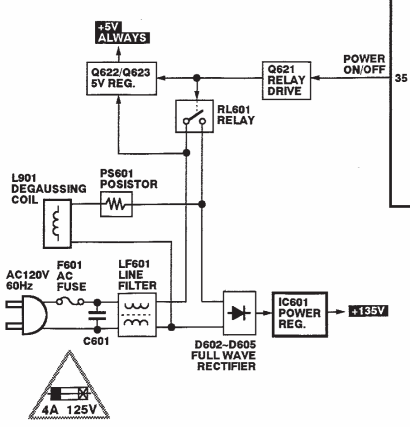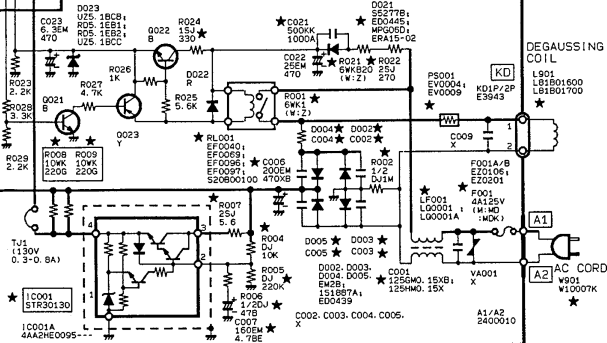I have this old SANYO CRT TV, which we bought all the way back in 1994. Originally used in our living room, it was moved to our bedroom many years ago, where it was used only occasionally, a few times a year.
Many years ago, it developed an intermittent problem: sometimes, as it was warming up, its picture began to jump, became distorted vertically and showing weird colors, with the audio becoming louder and distorted as well. This problem was usually fixed by the time-tested method of a well-aimed whack.
More recently, however, after it warmed up a little, the TV began emitting an awful, awful angry buzz. It didn't seem to come from its speakers, and it didn't sound like high voltage discharge either, more like a mechanical sound.
Now of course we don't really need this TV anymore. Still, I have this compulsion to try and fix broken things even when there is little or no practical utility. Call it a hobby, if you wish. So I wanted to know what was wrong with this TV.
CRT TV repair is, of course, not for the faint-hearted. The anode voltage of a color picture tube is about 25 kilovolts. And while the 25 kV circuit may not have enough energy to kill you, there are plenty of spots in the TV carrying hundreds of volts and more than enough amperage to cause an instant heart attack. In short, you better know what you are doing. I think I do, but I was extra careful, just in case, when taking the set apart and especially, when discharging the picture tube and removing the high voltage connector.

Visually examining the innards did not yield any clues. Sure, there was some discoloration near high wattage resistors, plenty of dust, but no obvious signs of damage: no blown capacitors, no burned-out parts.
At this time, I had a brilliant idea (or so I thought). I have a thermal infrared camera, so I decided to take pictures of the circuit board while it was powered, looking for obvious hot spots. There were plenty of warm bits, but nothing unduly hot, even as the unit was buzzing like crazy.
My immediate attention, however, was drawn to a relay on the left side of the circuit board (the rectangular black block slightly to the left of the large capacitor, above the two-wire connector for the degaussing circuit). I figured that this relay was on the fritz. The sound sounded very much like a relay misbehaving. And, surprise! I was able to find the exact same relay at aliexpress-ic.com, for the princely sum of USD 1.10, shipping to Canada included. Wow.
So I put the TV aside for a few weeks, and then when the relay arrived, I replaced it. With high hopes, I turned the set on, and... Buzz. Sorry, you lose.
But if it's not the relay, then what the devil was it? My attention next turned to one of the most curious components in an analog television, an ultrasonic delay line (blue block near the top, towards the right.) It is, after all, a thing that is designed to emit sound. What if it emits not just ultrasound? The function of this delay line has to do with picture quality, the set functions without it, so I desoldered it, expecting the TV to work. Work it did (with a slight moire pattern visible on the screen) but... Buzz. Sorry, you lose.
I kept poking around, looking for other possible causes, including broken solder joints. I actually found a few of those, including broken joints holding one of the highest-wattage resistors in the set. Resoldering these parts eliminated the other intermittent problem (the elongated, distorted picture and bad sound). But still... Buzz. Sorry, you lose.
All along, I have been trying to ascertain exactly what it was that was doing the buzzing. I tried holding a cardboard tube to my ear, to localize the sound, but it didn't really work. Then I read a brilliant idea: use a long wooden stick, with which you can actually touch suspect parts while holding the other end near your ear. I did just that and confirmed my original suspicion: it was the relay, after all, that was doing the buzzing. But why? Obviously, the relay itself was just fine, as its replacement was buzzing just the same.
I tried finding the service manual for this TV, but I was not successful. I did find service manuals for similar sets, though, and they helped me understand the function of the relay in question. For instance, here is a part of the block diagram of the SANYO AVM-2058G television set:

What this diagram tells me is that this relay controls power to much of the television set. What this diagram does not tell me is why this relay is making that horrible racket, and how come it does not affect the picture or sound.
Still, I was not prepared to give up. There is a site that sells service manuals. They listed the AVM-2664U, downloadable for a fee of USD 10.00. So be it, I said, that's why I keep a small amount on my PAYPAL account; I bit the bullet and bought the service manual.
It turned out to be much more detailed than the service manuals I found for free for other units; among other things, it contained the full schematic of my TV set, including the bits surrounding the relay in question.

My immediate attention was directed at the capacitor C023 and Zener diode D023. I first replaced the capacitor. The pulled capacitor measured just over 300 μF, giving me high hope that replacing it would solve the problem. So I reassembled the set, turned it on, and... Buzz. Sorry, you lose.
But I read somewhere that Zener diodes can go bad, too. And it so happened that I had the exact replacement for D023, a 5.1 V Zener diode. So I replaced that one as well, tried the set and... well, for a while, there was no buzz, so I was almost ready to declare victory, I just had to visit the bathroom first. As I was coming downstairs, I again heard the ominous buzz. Sorry, you lose.
Studying the circuit diagram a little further, I concluded that even more than C023, maybe C022 is the culprit. It does, after all, seem to stabilize the rectified voltage that powers the relay. I tried to measure its capacitance in-circuit but that didn't work, so I pulled it out. And its capacitance is... 0.090 μF. Yes, a teeny fraction of its nominal value of 470 μF.
I knew I had a winner already, I just had to look for a suitable replacement in my parts boxes. The original part had a voltage rating of 25 V, which I think was too low, and may have contributed to this part's early failure. I did not have 470 μF capacitors with a voltage rating of 25 V or above, but I did have 1000 μF capacitors rated 50 V, and in this particular case, I knew that a higher value was acceptable. The new capacitor was much bigger than the original but thankfully, there was plenty of room. So I put the new one in, reassembled the set, turned it on, and... Silence. That is to say, other than the normal sound from the broadcast, no other noises. No buzzing, no chirping, no crackling, no whine. The circuit board was quiet as a church mouse and stayed that way even as it was warming up.
After a few minutes, I was ready to declare victory. I fully reassembled the set, finding suitable holes for an additional 9 screws on the back. I then let the set run for a few hours. It worked flawlessly. So then, this was it... one lousy little capacitor that failed to smooth the current that fed the power relay, making the power relay buzz angrily like a mad hive of wasps.
Now only one question remains... what do I do with a fully functional, good quality (its picture is actually quite nice) 26" analog CRT television set that is so heavy and so hopelessly obsolete, not even thrift stores want it?


